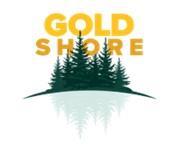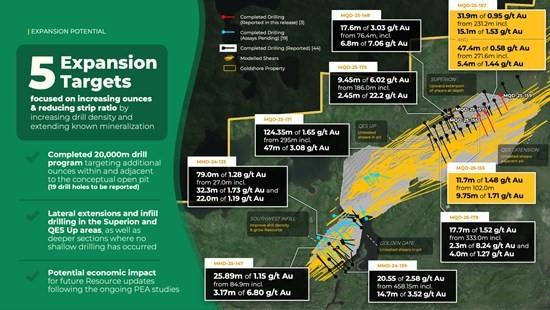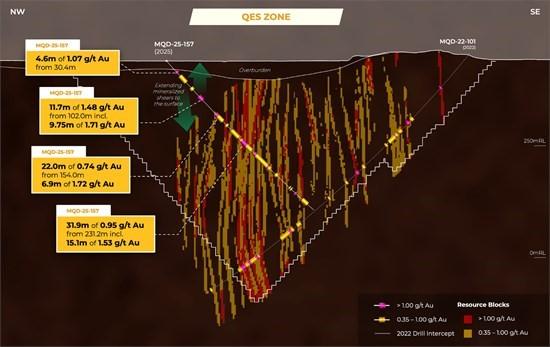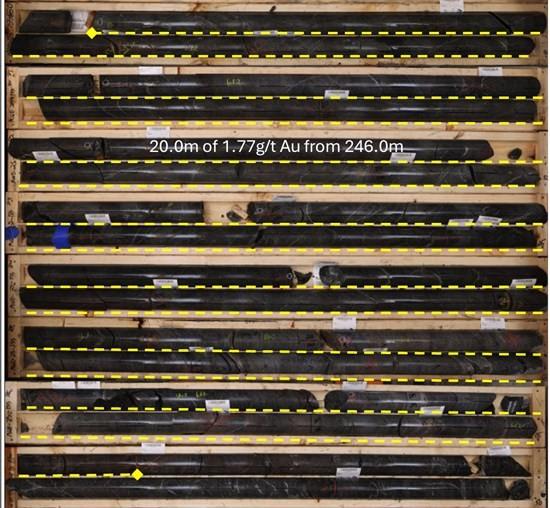
Goldshore Intersects 42.7m of 1.09 g/t Au at the Eastern QES Zone of the Moss Deposit

Goldshore Resources Inc. (TSX-V: GSHR) (OTCQB: GSHRF) (FSE: 8X00) is pleased to announce its latest assay results from its completed 20,000-meter drill program and the final results from the QES Up zone targeting the near surface extension of the most northern QES shears at the Moss Gold Project in Northwest Ontario, Canada. The drilling targeted the eastern side of the QES zone to confirm thickening of mineralization and its orientation.
Michael Henrichsen, CEO of Goldshore, commented, “We’re pleased with the continued positive results from the winter drilling with follow-up holes at the QES Zone intersecting wide intercepts of gold mineralized structure with some shears providing higher mineralization closer to surface. These results further support the potential for this region to support rapid payback in the early years of mining. This successful winter program sets the stage for our recently announced 50,000-meter drill program, focused on further resource expansion (29,000 meters) and grade control drilling (21,000 meters) which will ultimately set the stage for the infill drill program in 2026.”
Highlights:
- Results from two drill holes, which infilled significant drilling gaps in the QES Zone, intersected multiple wide intervals of gold-mineralized shear zones. The results confirmed the splaying of the QES zone into multiple shears on the eastern edge of the QES Zone with best intercepts of:
- 42.7m of 1.09 g/t Au from 241.6m in MQD-25-155, including
- 20.0m of 1.77 g/t Au from 246.0m, and
- 2.3m of 1.98 g/t Au from 282.0m, and
- 46.05m of 0.60 g/t Au from 290.0m, including
- 8.0m of 1.46 g/t Au from 309.0m
- 31.9m of 0.95 g/t Au from 231.2m in MQD-25-157, including
- 15.1m of 1.53 g/t Au from 233.4m, and
- 47.4m of 0.58 g/t Au from 271.6m, including
- 5.4m of 1.44 g/t Au from 272.0m, and
- 3.9m of 1.05 g/t Au from 310.3m
- Additionally, both holes confirmed the near surface extensions of deeper marginal shears along the northern edge of the QES Zone with some shears returning higher grade mineralization closer to surface with best intercepts of:
- 9.45m of 0.73 g/t Au from 156.0m in MQD-25-155, including
- 5.0m of 1.03 g/t Au from 159m
- 4.6m of 1.07 g/t Au from 30.4m in MQD-25-157, and
- 19.0m of 0.42 g/t Au from 43.0m, and
- 11.7m of 1.48 g/t Au from 102.0m, including
- 9.75m of 1.71 g/t Au from 103.0m, and
- 22.0m of 0.74 g/t Au from 154.0m, including
- 6.9m of 1.72 g/t Au from 154.4m
Technical Overview
Figure 1 shows the location of the drill holes being reported with respect to the completed winter drill program, while Figure 2 illustrates a cross section through drill hole MQD-25-157. Tables 1 & 2 summarize significant intercepts and drill hole locations, respectively.

Figure 1: Summarizes the completed winter 2025 drill program, which targeted resource expansion within the conceptual open pit outlined in grey. Drill holes being reported are highlighted in red.

Figure 2: Cross section through MQD-25-157 illustrating the mineralized core shears in the QES Zone, as well as the extension of marginal shears toward surface on the northern flank of the QES Zone (QES Up).
MQD-25-155 and MQD-25-157 were both drilled to test the QES Up target, which aims to prove the extension toward surface of deeper-modelled mineralized shear zones along the northern boundary of the QES Zone. The area targeted lies entirely within the conceptual open pit with all mineralized intersections representing opportunities to convert currently modelled waste to mineral resource. Both holes were extended through the entirety of the QES Zone, where they infilled gaps in the existing drilling. MQD-25-159 targeted a potential northern splay off the primary QES zone.
Holes MQD-25-155 and MQD-25-157 were drilled 100m apart targeting surface extensions of deeper-modelled mineralized shear zones along the northern boundary of the QES Zone. They are the two most eastern holes of the QES Up program. MQD-25-155 collared into a weakly deformed and chlorite-epidote altered diorite quickly transitioning to a sericite-silica-chlorite dominated alteration with localized 1-2% pyrite-chalcopyrite bearing, sericite-silica-hematite altered shears increasing in intensity and depth. MQD-25-157 collared directly into the sericite-silica-chlorite packages. The sericite-silica-hematite altered shears are moderately mineralized with intercepts including 9.45m of 0.73 g/t Au from 156.0m, including 5.0m of 1.03 g/t Au from 159m in MQD-25-155; and 4.6m of 1.07 g/t Au from 30.4m, 19.0m of 0.42 g/t Au from 43.0m, 11.7m of 1.48 g/t Au from 102.0m, including 9.75m of 1.71 g/t Au from 103.0m, and 22.0m of 0.74 g/t Au from 154.0m, including 6.9m of 1.72 g/t Au from 154.4m in MQD-25-157 (Table 1).
Both holes were extended into the QES namesake quartz eye granodiorite with pervasive sericite-silica-hematite alteration cut by shears hosting 3-5% pyrite-chalcopyrite mineralization. These shears host wide intercepts including 42.7m of 1.09 g/t Au from 241.6m, including 20.0m of 1.77 g/t Au from 246.0m and 2.3m of 1.98 g/t Au from 282.0m, 46.05m of 0.60 g/t Au from 290.0m, including 8.0m of 1.46 g/t Au from 309.0m, and 10.15m of 0.62 g/t Au from 421.0m in MQD-25-155; and 31.9m of 0.95 g/t Au from 231.2m, including 15.1m of 1.53 g/t Au from 233.4m, 47.4m of 0.58 g/t Au from 271.6m, including 5.4m of 1.44 g/t Au from 272.0m, 3.9m of 1.05 g/t Au from 310.3m, 3.25m @ 2.60 g/t Au from 392.5m, and 15.4m of 0.53 g/t Au from 413.3m in MQD-25-157. Additional minor lower grade shears are outlined in Table 1.
MQD-25-159 was drilled an additional 300m northeast of MQD-25-177 targeting a potential splay of the QES Zone. The hole collared into the typical northern epidote-chlorite altered diorite with infrequent local sericite-silica shearing. These local shears were anomalous for gold but were too sporadically spaced to create reportable intervals. The hole was extended to intersect the sericite-silica-hematite QES granodiorite to confirm the orientation of the lithological domain which was intersected at 258.4m after which the hole was terminated in mineralization. The hole intersected several 5-10 meter wide, 2-3% pyrite bearing shears, that returned low grade mineralized intercepts including 4.40m of 0.55 g/t Au from 261.45m and 4.45m of 0.43 g/t Au from 293.1m.

Figure 3: Sheared and mineralized granodiorite in MQD-25-155 returning 20.0m of 1.77 g/t Au from 246m along the eastern edge of the QES Zone.
Table 1: Significant intercepts
| HOLE ID | FROM | TO | LENGTH (m) |
TRUE WIDTH (m) |
CUT GRADE (g/t Au) |
UNCUT GRADE (g/t Au) |
| MQD-25-155 | 48.00 | 50.00 | 2.00 | 1.4 | 0.57 | 0.57 |
| 156.00 | 165.45 | 9.45 | 6.9 | 0.73 | 0.73 | |
| incl | 159.00 | 164.00 | 5.00 | 3.6 | 1.03 | 1.03 |
| 222.00 | 225.00 | 3.00 | 2.2 | 0.35 | 0.35 | |
| 228.00 | 231.35 | 3.35 | 2.5 | 0.59 | 0.59 | |
| 241.60 | 284.30 | 42.70 | 31.7 | 1.09 | 1.09 | |
| incl | 246.00 | 266.00 | 20.00 | 14.8 | 1.77 | 1.77 |
| and | 282.00 | 284.30 | 2.30 | 1.7 | 1.98 | 1.98 |
| 290.00 | 336.05 | 46.05 | 34.5 | 0.60 | 0.60 | |
| incl | 309.00 | 317.00 | 8.00 | 6.0 | 1.46 | 1.46 |
| 354.25 | 357.65 | 3.40 | 2.5 | 0.43 | 0.43 | |
| 372.25 | 374.35 | 2.10 | 1.6 | 0.32 | 0.32 | |
| 379.05 | 383.80 | 4.75 | 3.6 | 0.46 | 0.46 | |
| 390.00 | 392.25 | 2.25 | 1.7 | 0.49 | 0.49 | |
| 404.95 | 408.00 | 3.05 | 2.3 | 0.37 | 0.37 | |
| 421.00 | 431.15 | 10.15 | 7.7 | 0.62 | 0.62 | |
| 441.00 | 448.60 | 7.60 | 5.8 | 0.51 | 0.51 | |
| MQD-25-157 | 30.40 | 35.00 | 4.60 | 3.1 | 1.07 | 1.07 |
| 43.00 | 62.00 | 19.00 | 12.8 | 0.42 | 0.42 | |
| 77.40 | 84.00 | 6.60 | 4.5 | 0.35 | 0.35 | |
| 102.00 | 113.70 | 11.70 | 8.0 | 1.48 | 1.48 | |
| incl | 103.00 | 112.75 | 9.75 | 6.7 | 1.71 | 1.71 |
| 133.00 | 142.00 | 9.00 | 6.2 | 0.33 | 0.33 | |
| 154.00 | 176.00 | 22.00 | 15.3 | 0.74 | 0.74 | |
| incl | 154.40 | 161.30 | 6.90 | 4.8 | 1.72 | 1.72 |
| 186.10 | 190.50 | 4.40 | 3.1 | 0.47 | 0.47 | |
| 203.40 | 224.00 | 20.60 | 14.4 | 0.48 | 0.48 | |
| 231.20 | 263.10 | 31.90 | 22.4 | 0.95 | 0.95 | |
| incl | 233.40 | 248.50 | 15.10 | 10.6 | 1.53 | 1.53 |
| incl | 239.00 | 239.75 | 0.75 | 0.5 | 16.5 | 16.5 |
| 271.60 | 319.00 | 47.40 | 33.7 | 0.58 | 0.58 | |
| incl | 272.00 | 277.40 | 5.40 | 3.8 | 1.44 | 1.44 |
| and | 310.30 | 314.20 | 3.90 | 2.8 | 1.05 | 1.05 |
| 334.50 | 340.50 | 6.00 | 4.3 | 0.37 | 0.37 | |
| 358.25 | 361.40 | 3.15 | 2.3 | 0.34 | 0.34 | |
| 375.50 | 377.70 | 2.20 | 1.6 | 0.35 | 0.35 | |
| 380.00 | 382.50 | 2.50 | 1.8 | 0.46 | 0.46 | |
| 392.50 | 395.75 | 3.25 | 2.4 | 2.60 | 2.60 | |
| incl | 394.80 | 395.30 | 0.50 | 0.4 | 15.4 | 15.4 |
| 413.30 | 428.70 | 15.40 | 11.4 | 0.53 | 0.53 | |
| MQD-25-159 | 261.45 | 265.85 | 4.40 | 3.3 | 0.55 | 0.55 |
| 293.10 | 297.55 | 4.45 | 3.3 | 0.43 | 0.43 | |
|
Intersections calculated above a 0.3 g/t Au cut off with a top cut of 30 g/t Au and a maximum internal waste interval of 5 metres. Shaded intervals are intersections calculated above a 1.0 g/t Au cut off. Intervals in bold are those with a grade thickness factor exceeding 20 gram x metres / tonne gold. True widths are approximate and assume a subvertical body. |
||||||
Table 2: Drill Collars
| HOLE | EAST | NORTH | RL | AZIMUTH | DIP | EOH |
| MQD-25-155 | 670,282 | 5,379,941 | 427 | 156.1 | -49.9 | 450.00 |
| MQD-25-157 | 670,372 | 5,379,985 | 428 | 155.7 | -50.0 | 447.10 |
| MQD-25-159 | 670,566 | 5,380,206 | 428 | 155.0 | -44.4 | 300.00 |
Analytical and QA/QC Procedures
The HQ diameter drill core has been oriented using ACTIII or equivalent tools and validated in the core shack. All core has been sawed in half cut just off the core orientation line (bottom of hole) with the right half (looking down hole) of the core bagged and sent to a third-party analytical laboratory. The left half of the core was returned to core boxes and is stored at Goldshore’s Kashabowie core yard facility.
All samples were sent to ALS Geochemistry in Thunder Bay for preparation and analysis was performed in the ALS Vancouver analytical facility. ALS is accredited by the Standards Council of Canada (SCC) for the Accreditation of Mineral Analysis Testing Laboratories and CAN-P-4E ISO/IEC 17025. Samples were analysed for gold via fire assay with an AA finish and 48 pathfinder elements via ICP-MS after four-acid digestion. Samples that assayed over 10 ppm Au were re-run via fire assay with a gravimetric finish.
In addition to ALS quality assurance / quality control protocols, Goldshore has implemented a quality control program for all samples collected through the drilling program. The quality control program was designed by a qualified and independent third party, with a focus on the quality of analytical results for gold. Analytical results are received, imported to our secure on-line database and evaluated to meet our established guidelines to ensure that all sample batches pass industry best practice for analytical quality control. Certified reference materials are considered acceptable if values returned are within three standard deviations of the certified value reported by the manufacture of the material. In addition to the certified reference material, certified blank material is included in the sample stream to monitor contamination during sample preparation. Blank material results are assessed based on the returned gold result being less than ten times the quoted lower detection limit of the analytical method. The results of the on-going analytical quality control program are evaluated and reported to Goldshore by Orix Geoscience Inc.
Investor Awareness and Marketing Agreement
The Company has retained Bluehand Consulting AG to provide ongoing digital media marketing services. Bluehand will work to facilitate investor awareness about the Company and its gold exploration projects. Bluehand will be paid EUR 200,000 to develop required content and for advertising. The term of this agreement shall be effective as of July 1, 2025 and will end on July 31, 2025. The budget allocated to Bluehand may be adjusted during the term based on market conditions and Company requirements, and the agreement may be renewed upon mutual agreement. The Company will not issue any securities to Bluehand in consideration for the services. Neither Bluehand, nor Matthias Oberli, the authorized individual of Bluehand, have any prior relationship with the Company and the Company deals at arm’s length with both Bluehand and Mr. Oberli. Additionally, neither Bluehand nor Mr. Oberli have any interest, directly or indirectly, in the Company or its securities, or any right or intent to acquire such an interest. Contact information for Bluehand is as follows: email: info@bluehandconsulting.ch; mailing address: Bartholoméplatz 3, 7310 Bad Ragaz, Switzerland; phone: +41 764802584.
Qualified Person
Peter Flindell, PGeo, MAusIMM, MAIG, Vice-President, Exploration, of the Company, and a qualified person under National Instrument 43-101 – Standards of Disclosure for Mineral Projects, has approved the scientific and technical information contained in this news release.
Mr. Flindell has verified the data disclosed in this news release. To verify the information related to the winter drill program at the Moss Gold Project, Mr. Flindell has visited the property several times; discussed and reviewed logging, sampling, bulk density, core cutting and sample shipping processes with responsible site staff; discussed and reviewed assay and QA/QC results with responsible personnel; and reviewed supporting documentation, including drill hole location and orientation and significant assay interval calculations. He has also overseen the Company’s health and safety policies in the field to ensure full compliance, and consulted with the Project’s host indigenous communities on the planning and implementation of the drill program, particularly with respect to its impact on the environment and the Company’s remediation protocols.
About Goldshore
Goldshore is a growth-oriented gold company focused on delivering long-term shareholder and stakeholder value through the acquisition and advancement of primary gold assets in tier-one jurisdictions. It is led by the ex-global head of structural geology for the world’s largest gold company and backed by one of Canada’s pre-eminent private equity firms. The Company’s current focus is the advanced stage 100% owned Moss Gold Project which is positioned in Ontario, Canada, with direct access from the Trans-Canada Highway, hydroelectric power near site, supportive local communities and skilled workforce. The Company has invested over $75 million of new capital and completed approximately 100,000 meters of drilling on the Moss Gold Project, which, in aggregate, has had over 255,000 meters of drilling. The 2024 updated NI 43-101 mineral resource estimate has expanded to 1.54 million ounces of Indicated gold resources at 1.23 g/t Au and 5.20 million ounces of Inferred gold resources at 1.11 g/t Au. The MRE only encompasses 3.6 kilometers of the 35+ kilometer mineralized trend, remains open at depth and along strike and is one of the few remaining major Canadian gold deposits positioned for development in this cycle. Please see NI 43-101 technical report titled: “Technical Report and Updated Mineral Resource Estimate for the Moss Gold Project, Ontario, Canada,” dated March 20, 2024 with an effective date of January 31, 2024 available under the Company’s SEDAR+ profile at www.sedarplus.ca.
MORE or "UNCATEGORIZED"
Kuya Silver Confirms High-Grade Silver-Gold Vein Mineralization at Umm-Hadid with Initial Drill Results up to 1483.9 g/t AgEq over 2 Metres
Kuya Silver Corporation (CSE: KUYA) (OTCQB: KUYAF) (FSE: 6MR1) is... READ MORE
First Phosphate Closes Final Tranche of Oversubscribed Private Placement
First Phosphate Corp. (CSE: PHOS) (OTCQX: FRSPF) (FSE: KD0) is... READ MORE
GFG Receives Final Payment from the Sale of its Rattlesnake Hills Gold Project
GFG Resources Inc. (TSX-V: GFG) (OTCQB: GFGSF) announces that i... READ MORE
Goliath Receives $1,730,882 Through Warrant Exercises, Inclusive Of Crescat Capital A Longtime Strategic And Cornerstone Shareholder
Goliath Resources Limited (TSX-V: GOT) (OTCQB: GOTRF) (FSE: B4IF)... READ MORE
Robex Pours First Gold at Kiniéro on Schedule and Budget
Highlights: Gold bar weighing 2.64 kilograms (85 oz) poured in th... READ MORE












